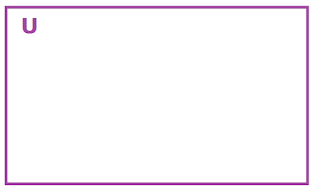Set – Empty Set – Definition – Example & Venn Diagram
Empty set
A set which does not contain any element is called an Empty set, or null set or void set.
Empty set is denoted by { } or ∅ (Greek letter phi).
Curly braces having no elements on it.
Example: 1. The set of natural numbers less than 0, because there is no elements in the empty set.
We know that there is no natural number less than 0.
Therefore, it is an empty set.
2. A = {x : x ∈ N, 6 < x < 7}
Here A is an empty set, because there is no natural number between 6 and 7.
3. Let C be the set of all those people whose weight is greater than 500 kg. According to the present statistical analysis of the world a person exists whose weight is greater than 500 kg, so C is an empty set.
4. A = Set of odd numbers which are divisible by 2, is an empty set.
Cardinality of an empty set
Cardinality(number of elements) or size of a empty set is zero.
Cardinality of a set is the measure of the numbers of elements in a set.
Example: A set contains counting numbers less than 6 has a cardinality of 5, because it has five elements(1, 2, 3, 4, 5).
We write it this way |A| = 5.
The vertical bars on both sides of A indicate the cardinality of set A.
The cardinality of the empty set is zero, because the empty set has no elements, we can write |∅| = 0.
When we draw a venn diagram for a null set ∅, or to draw a null set, we only draw a venn diagram without any shading, below are several different type of examples of the null sets.
∅
∅
∅
∅
Properties of empty sets
The union of any set with the empty set is the set itself, because an empty set have no elements.
So when we form the union of two sets, we are not add any elements to the other set.
In Symbol, we write X ∅ U = ∅.
The intersection of any two sets with one empty set is the empty set, because an empty set have no elements.
So when we form the intersection of two sets, we have no common elements.
In Symbol, we write X U ∅ = X.
The empty set is subset of any set, because when we form subsets of a set A, we use no elements at all from A.
This gives us the empty set. The complement of the empty set is the universal set.



